
Designing a new car typically involves long hours staring at a computer screen, then even more time spent shaping clay models and interior mockups. Volvo and Varjo, a Finnish developer of augmented-reality headsets, want to inject more tech into the process. The two companies have created what they call a “world’s first mixed reality approach” to car development.
Automakers like Ford and Nissan have used virtual-reality headsets to let designers work on cars digitally, but Volvo is taking things a step further. The Swedish automaker claims testers can wear one of Varjo’s headsets while driving a real car, overlaying virtual elements on top of what the driver actually sees. This allows designers and engineers to evaluate new features digitally, saving time in the development process, Volvo claims.
“With this mixed reality approach, we can start evaluating designs and technologies while they are literally still on the drawing board,” Henrik Green, Volvo chief technology officer, said in a statement. “Instead of the usual static way of evaluating new products and ideas, we can test concepts on the road immediately. This approach offers considerable potential cost savings by identifying priorities and clearing bottlenecks much earlier in the design and development process.”
This blending of virtual and real worlds is possible thanks to Varjo’s new XR-1 headset, according to Volvo. The XR-1’s high-definition resolution is better than any other headset currently available, making it the only one suitable for this application, Volvo claims. Note that Volvo previously invested in Varjo through its in-house Tech Fund, and the automaker is likely eager to see a return on that investment.
The XR-1 headset also has eye-tracking tech, which Volvo hopes to use to measure driver distraction. Monitoring where a driver looks can help determine how customers will use new features and whether those features will cause distraction, according to Volvo. Always obsessed with safety, Volvo already committed to adding driver-facing cameras to its production cars in order to combat distracted and intoxicated driving.
Car design is a complex process. Automakers need to account for myriad safety regulations, market-specific quirks, and engineering demands, all while creating a car that looks attractive. Volvo believes augmented reality will help make that process a little easier, but the application of augmented reality in cars might not stop there. Nissan is experimenting with so-called “invisible-to-visible” tech that uses an augmented reality interface to give drivers more information.


